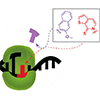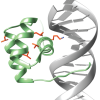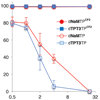In vivo structure–activity relationships and optimization of an unnatural base pair for replication in a semi-synthetic organism
A.W. Feldman, F.E. Romesberg, J Am Chem Soc (2017) 139:11427–11433.
 We screened 135 candidate UBPs for optimal performance in an SSO, comparing the resulting in vivo SARs to those collected previously in vitro. In addition to some interesting differences, the present screen identified four UBPs whose retention in the DNA of an SSO is higher than that of dNaM-dTPT3, which was previously the most promising UBP identified.
We screened 135 candidate UBPs for optimal performance in an SSO, comparing the resulting in vivo SARs to those collected previously in vitro. In addition to some interesting differences, the present screen identified four UBPs whose retention in the DNA of an SSO is higher than that of dNaM-dTPT3, which was previously the most promising UBP identified.
 We show that the evolved Stoffel fragment mutant, SFM4-3, efficiently transcribes RNA or 2′-F-modified RNA and that it also efficiently PCR amplifies oligonucleotides of mixed RNA and DNA composition. Using thermocycling and a novel DNA template, we demonstrate a polymerase chain transcription (PCT) reaction that results in the exponential production of orders of magnitude more RNA or modified RNA than is available by conventional transcription.
We show that the evolved Stoffel fragment mutant, SFM4-3, efficiently transcribes RNA or 2′-F-modified RNA and that it also efficiently PCR amplifies oligonucleotides of mixed RNA and DNA composition. Using thermocycling and a novel DNA template, we demonstrate a polymerase chain transcription (PCT) reaction that results in the exponential production of orders of magnitude more RNA or modified RNA than is available by conventional transcription. We report a steady-state kinetic characterization of the rate with which the Klenow fragment of E. coli DNA polymerase I synthesizes the dNaM-dTPT3 UBP and its mispairs in a variety of sequence contexts. The data demonstrate that dNaMTP and dTPT3TP are well optimized and standardized parts for the expansion of the genetic alphabet.
We report a steady-state kinetic characterization of the rate with which the Klenow fragment of E. coli DNA polymerase I synthesizes the dNaM-dTPT3 UBP and its mispairs in a variety of sequence contexts. The data demonstrate that dNaMTP and dTPT3TP are well optimized and standardized parts for the expansion of the genetic alphabet. ACS Editors’ Choice: We introduce C-D bonds within different structural elements in the Drosophila transcription factor bicoid, a homeodomain protein with morphogenic activity. C-D absorptions are characterized in the free and DNA-bound states, as well as during thermal denaturation. Residues in the DNA recognition helix, but not other helices, exhibit multiple conformations, and overall the data are consistent with the existence of multiple stable conformations in the folded state.
ACS Editors’ Choice: We introduce C-D bonds within different structural elements in the Drosophila transcription factor bicoid, a homeodomain protein with morphogenic activity. C-D absorptions are characterized in the free and DNA-bound states, as well as during thermal denaturation. Residues in the DNA recognition helix, but not other helices, exhibit multiple conformations, and overall the data are consistent with the existence of multiple stable conformations in the folded state. We report the selection and characterization of 2′-F purine aptamers that bind human neutrophil elastase (HNE) with reasonable affinity. The 2′-F substituents are found to facilitate the selection of specific interactions, and we demonstrate than only a few can optimize properties far beyond simple nuclease resistance.
We report the selection and characterization of 2′-F purine aptamers that bind human neutrophil elastase (HNE) with reasonable affinity. The 2′-F substituents are found to facilitate the selection of specific interactions, and we demonstrate than only a few can optimize properties far beyond simple nuclease resistance. We report the synthesis and evaluation of unnatural triphosphates with their β,γ-bridging oxygen replaced with a difluoromethylene moiety, yielding dNaMTPCF2 and dTPT3TPCF2. We find that although dNaMTPCF2 cannot support in vivo replication, likely due to poor polymerase recognition, dTPT3TPCF2 can, and moreover, its increased stability can contribute to increased UBP retention. The results demonstrate the promise of a chemical approach to SSO optimization.
We report the synthesis and evaluation of unnatural triphosphates with their β,γ-bridging oxygen replaced with a difluoromethylene moiety, yielding dNaMTPCF2 and dTPT3TPCF2. We find that although dNaMTPCF2 cannot support in vivo replication, likely due to poor polymerase recognition, dTPT3TPCF2 can, and moreover, its increased stability can contribute to increased UBP retention. The results demonstrate the promise of a chemical approach to SSO optimization. We describe an optimized SSO that is healthy, more autonomous than
We describe an optimized SSO that is healthy, more autonomous than  We review the strengths and weaknesses of the different transparent window vibrational probes, methods by which they may be site-specifically incorporated into peptides and proteins, and the physicochemical properties they may be used to study. These topics are put into context through four case studies focused on KSI, SH3, DHFR, and cyt c.
We review the strengths and weaknesses of the different transparent window vibrational probes, methods by which they may be site-specifically incorporated into peptides and proteins, and the physicochemical properties they may be used to study. These topics are put into context through four case studies focused on KSI, SH3, DHFR, and cyt c. We serve as guest editors for a special issue of Bioorg. Med. Chem. In this preface, we give a bit of background on drug discovery and the impending crisis posed by antibiotic resistance, as well as an overview of the contributed articles.
We serve as guest editors for a special issue of Bioorg. Med. Chem. In this preface, we give a bit of background on drug discovery and the impending crisis posed by antibiotic resistance, as well as an overview of the contributed articles. We review how the inhibition of SPase may affect bacterial virulence, and how SPase itself contributes to functions beyond mediating bacterial secretion.
We review how the inhibition of SPase may affect bacterial virulence, and how SPase itself contributes to functions beyond mediating bacterial secretion.